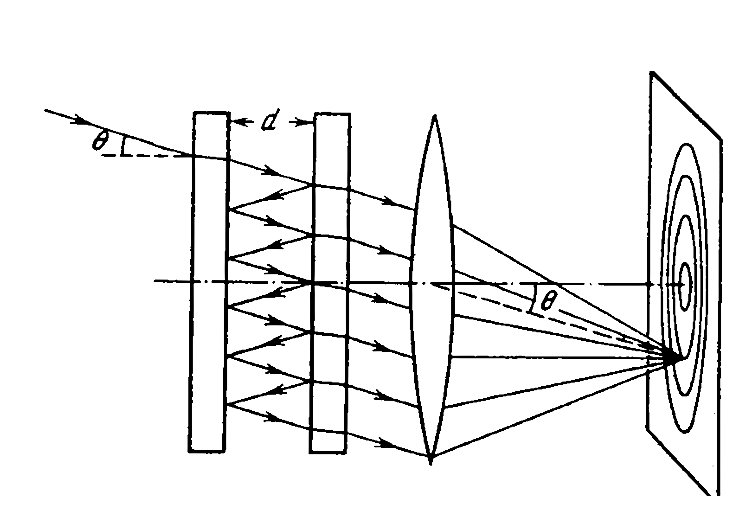When a Fabry-Perot etalon is illuminated by monochrmatic light with wavelength λ an interference pattern, the system of concentric rings, appears in the focal plane of a lens (Fig.) The thickness of the etalom is equal to d. Determine how

(a) the position of rings,
(b) the angular width of fringes depends on the order of interference.
The path difference between (1)&(2) can be seen to be
Δ=2dsecθ−2dtanθsinθ
=2dcosθ=kλ
for maxima. Here k= half-interger.
The order of interference decreases as θ increases i.e. as the radius of the rings increases.
(b) Differentiating
2dsinθ∂θ=λ
on putting ∂k=−1. Thus
∂θ=λ2dsinθ
∂θ decreases as θ increases.

Topper's Solved these Questions
- OPTICSBOOK - IE IRODOV, LA SENA & SS KROTOVCHAPTER - OPTICSEXERCISE - Diffraction Of Light
60 Videos
- OPTICSBOOK - IE IRODOV, LA SENA & SS KROTOVCHAPTER - OPTICSEXERCISE - Polarization Of Light
43 Videos
- OPTICSBOOK - IE IRODOV, LA SENA & SS KROTOVCHAPTER - OPTICSEXERCISE - Exercise
2 Videos
- MECHANICSBOOK - IE IRODOV, LA SENA & SS KROTOVCHAPTER - MECHANICSEXERCISE - Mechanics Problems
92 Videos
- OSCILLATIONS AND WAVESBOOK - IE IRODOV, LA SENA & SS KROTOVCHAPTER - OSCILLATIONS AND WAVESEXERCISE - Electromagnetic Waves, Radiation
36 Videos
Similar Questions
Figure shows a narrow slit S illuminated b a monochromatic light of wavelength λ in a double-slit experiment. In the path of the rays reaching the upper slit S1, a tube to length L is interposed in which the index of reflection of the medium varies linearly as shown in figure . The position of the central maximum in the interference pattern on the screen was displaceed by N fringes. Find the value of N in terms of μ0, L and λ.


View SolutionA Lloyd's mirror or length 5 cm is illuminated with mon ochromatic light of wavelength λ(=6000Å) from a narrow 1 mm slit in its plane and 5 cm plane from its near edge. Find the fringe width on a screen 120 cm from the slit and width of interference pattern on the screen.

View SolutionYDSE is conducted using light of wavelength 6000Å to observe an interference pattern. When a film of some material 3.0×10−3 cm thick was placed over one of the slits, the fringe pattern shifted by a distance equal to 10 fringe widths. What is the refractive index of the material of the film ?
View SolutionFigure illumstrates an interferometer used in measurements of refreactive indices of transparent substances. Here S is

a narrow slit illuminated by monochromatic light with wavelength λ=589nm, 1 and 2 are identical tubes with air of length l=10.0cm each, D is a diaphragm with two slits. After the air in tube I was replaced with ammonia gas, the interference pattern on the screen Sc was displaced upwards by N=17 fringes. The refreactive indec of air is equal to n=1.000277. Determine the refractive index of ammonia gas.
View SolutionFor the Fabry-Perot etalon of thickness d=2.5cm find:
(a) the highest order of interference of light with wavelength λ=0.50μm,
(b) the dispersion region Δλ, i.e the spectral interval of wavelengths, within which there is still no overlap with orders of interference if the observation is carried out appoximately at wavelength λ=0.50μm.
View SolutionIn a single-slit diffraction experiment, light of wavelength λ illuminates the slit of width 'a' and the diffraction pattern is observed on a screen.
(a) Show the intensity distribution in the pattern with the angular position θ.
(b) How are the intensity and angular width of central maxima affected when
(i) width of slit is increased, and
(ii) separation between slit and screen is decreased ?
View SolutionYDSE is conducted using light of wavelength 6000 Å to observe interference pattern. When a film of material 3.0×10−3cm thick was placed over one of the slits, the fringe pattern shifted by a distance equal to 10 fringe widths. The refractive index of the material of the film is _ _ _ _ _ .
View Solution(a) Derive the relation a sinθ=λ for the first minimum of the diffraction pattern produced due to a single slit of width ‘a’ using light of wavelengthλ.
(b) State with reason, how the linear width of central maximum will be affected if
(i) monochromatic yellow light is replaced with red light, and
(ii) distance between the slit and the screen is increased.
(c) Using the monochromatic light of same wavelength in the experimental set-up of the diffraction pattern as well as in the interference pattern where the slit separation is 1 mm, 10 interference fringes are found to be within the central maximum of the diffraction pattern. Determine the width of the single slit, if the screen is kept at the same distance from the slit in the two cases.
View Solution(a) Derive the relation asinθ=λ for the first minimum of the diffraction pattern produced due to a single-slit of width 'a' using light of wavelength λ.
(b) State with reason, how the linear width of central maximum will be affected if (i) monochromatic yellow light is replaced with red light, and (ii) distance between the slit and the screen is increased.
(c) using the monochromatic light of same wavelength in the experimental set-up of the diffraction pattern as well as in the interference pattern where the slit separation is 1mm, 10 interference fringes are found to be within the central maximum of the diffraction pattern. determine the width of the single-slit, if the screen is kept at the same distance from the slit in the two cases.
View SolutionA double slit S1−S−2 is illuminated by a coherent light of wavelength λ. The slits are separated by a distance d. A plane mirror is placed in front of the double slit at a distance D1, from it and a screen ∑ is placed behind the double slit at a distance D2, from it . The screen ∑ receives only the light reflected by the mirror. Find the fringe-width of the interference pattern on the screen.

View Solution
